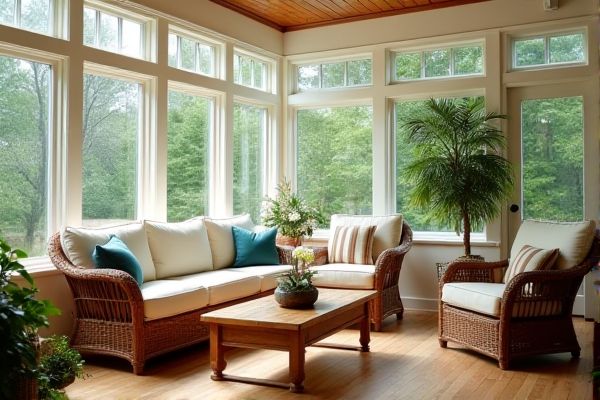
Resin wicker offers superior durability and weather resistance compared to natural wicker, making it ideal for sunrooms exposed to humidity and sunlight. Discover how choosing the right material can enhance your sunroom's comfort and longevity by reading the rest of the article.
Table of Comparison
| Feature | Resin Wicker | Natural Wicker |
|---|---|---|
| Material | Synthetic resin (PE, PVC) | Natural plant fibers (rattan, reed, bamboo) |
| Durability | Highly durable, weather-resistant | Less durable, prone to cracking and fading |
| Maintenance | Low maintenance, easy to clean | High maintenance, requires regular care |
| UV Resistance | UV-resistant, color retains longer | Not UV-resistant, colors fade over time |
| Water Resistance | Waterproof, suitable for humid sunrooms | Absorbs moisture, risk of mold and mildew |
| Comfort | Consistent texture, smooth finish | Natural texture, may have rough edges |
| Eco-Friendliness | Synthetic, less eco-friendly | Biodegradable, eco-friendly |
| Cost | Moderate to high | Varies, generally lower |
| Ideal Use | Sunrooms, outdoor patios, humid environments | Indoor sunrooms, low humidity settings |
Introduction to Wicker Materials in Sunrooms
Resin wicker and natural wicker are popular materials used in sunroom furniture due to their distinct characteristics and durability. Resin wicker, made from synthetic fibers, offers superior weather resistance and low maintenance, making it ideal for humid or sun-exposed environments. Natural wicker, sourced from plant fibers like rattan or bamboo, provides a classic aesthetic with a warm, organic texture but requires more care to prevent moisture damage and fading.
What Is Resin Wicker?
Resin wicker is a synthetic material made from polyethylene or other durable plastics designed to mimic the look and texture of natural wicker while offering enhanced resistance to moisture, UV rays, and temperature fluctuations. Unlike natural wicker derived from plant fibers such as rattan, reed, or bamboo, resin wicker is woven around a sturdy aluminum or steel frame, ensuring longevity and low maintenance in sunroom environments. This combination of materials makes resin wicker ideal for outdoor and indoor sunrooms, providing a stylish, weather-resistant alternative to traditional natural wicker furniture.
What Is Natural Wicker?
Natural wicker is a traditional material made from plant fibers such as rattan, bamboo, willow, and reed, commonly used in sunroom furniture for its authentic, organic look and breathable texture. It offers a lightweight and flexible design but requires regular maintenance to protect against moisture and UV damage, making it less durable in humid or outdoor environments. Natural wicker's natural composition provides an eco-friendly option, though it may lose its color and structural integrity faster compared to synthetic alternatives like resin wicker.
Durability: Resin Wicker vs. Natural Wicker
Resin wicker offers superior durability compared to natural wicker, as it is resistant to moisture, UV rays, and temperature fluctuations, making it ideal for sunroom furniture exposed to varying environmental conditions. Natural wicker, made from plant fibers like rattan or willow, tends to deteriorate over time when exposed to humidity and sunlight, leading to cracking and fading. Choosing resin wicker enhances longevity and reduces maintenance needs in sunroom settings.
Weather Resistance and Sunroom Conditions
Resin wicker offers superior weather resistance compared to natural wicker, making it ideal for sunroom conditions where exposure to humidity and temperature fluctuations is common. Natural wicker tends to absorb moisture, leading to warping and mildew, while resin wicker resists UV rays and maintains its durability without fading or cracking. Choosing resin wicker for your sunroom furniture ensures longevity and minimal maintenance in changing weather conditions.
Maintenance Requirements Compared
Resin wicker requires significantly less maintenance than natural wicker, as it is highly resistant to moisture, UV rays, and mildew, making it ideal for sunroom environments prone to humidity and sunlight exposure. Natural wicker, crafted from plant materials like rattan or bamboo, demands regular cleaning, protective treatments, and caution to avoid deterioration from moisture and prolonged sun exposure. Choosing resin wicker enhances durability and reduces the need for frequent upkeep, ensuring long-lasting aesthetic appeal in sunroom furniture.
Aesthetic Differences in Sunroom Design
Resin wicker offers a sleek and uniform appearance with consistent color and texture, making it ideal for contemporary sunroom designs that prioritize durability and low maintenance. Natural wicker provides a warm, organic aesthetic with unique variations in weave and tone, perfect for creating a cozy and rustic atmosphere in sunrooms. Choosing between resin and natural wicker in sunroom design depends on the desired balance of style, authenticity, and ease of upkeep.
Comfort and Functionality in Sunroom Furniture
Resin wicker offers superior durability and moisture resistance, making it ideal for sunroom furniture exposed to fluctuating temperatures and humidity. Natural wicker provides a traditional, organic aesthetic but requires more maintenance and is less resilient to sunroom environments with high moisture. Comfort is enhanced in resin wicker through modern weaving techniques and cushioned designs, ensuring longevity and ease of use while maintaining a stylish appearance.
Eco-Friendliness and Sustainability
Resin wicker is made from synthetic materials such as polyethylene, offering durability and resistance to weather but has a larger carbon footprint due to its production from petroleum-based plastics. Natural wicker, typically crafted from rattan, bamboo, or willow, is biodegradable and renewable, making it more eco-friendly and sustainable when sourced responsibly. However, natural wicker requires careful maintenance and may degrade faster in outdoor sunroom environments, potentially leading to more frequent replacements.
Choosing the Best Wicker Option for Your Sunroom
Resin wicker offers superior durability and weather resistance, making it an excellent choice for a sunroom exposed to fluctuating temperatures and sunlight. Natural wicker, crafted from organic materials, provides a classic, warm aesthetic but requires more maintenance to prevent damage from moisture and UV light. When choosing the best wicker option for your sunroom, consider your lifestyle and environment to balance style, comfort, and long-term performance.
 homyna.com
homyna.com